Quality Management in a Care Setting: Strategies and Analysis
VerifiedAdded on 2021/06/17
|18
|4264
|56
Report
AI Summary
This report provides a comprehensive analysis of total quality management (TQM) in a care setting, emphasizing the significance of quality improvement, teamwork, and continuous improvement processes. It explores the need for quality improvement to achieve optimal results for service users, highlighting the importance of teamwork in care settings, and the application of the continuous improvement process. The report also details strategies for integrating systems and structures to promote the rights, responsibilities, and diversity of service users. It examines various aspects of quality improvement, including employee perspectives, the evolution of healthcare, and the role of technology. The report further discusses the application of CQI, team effectiveness, and motivational theories. Finally, it highlights the need for continuous evaluation of quality improvement initiatives through various methods, including the use of electronic medical data and external agency assessments.
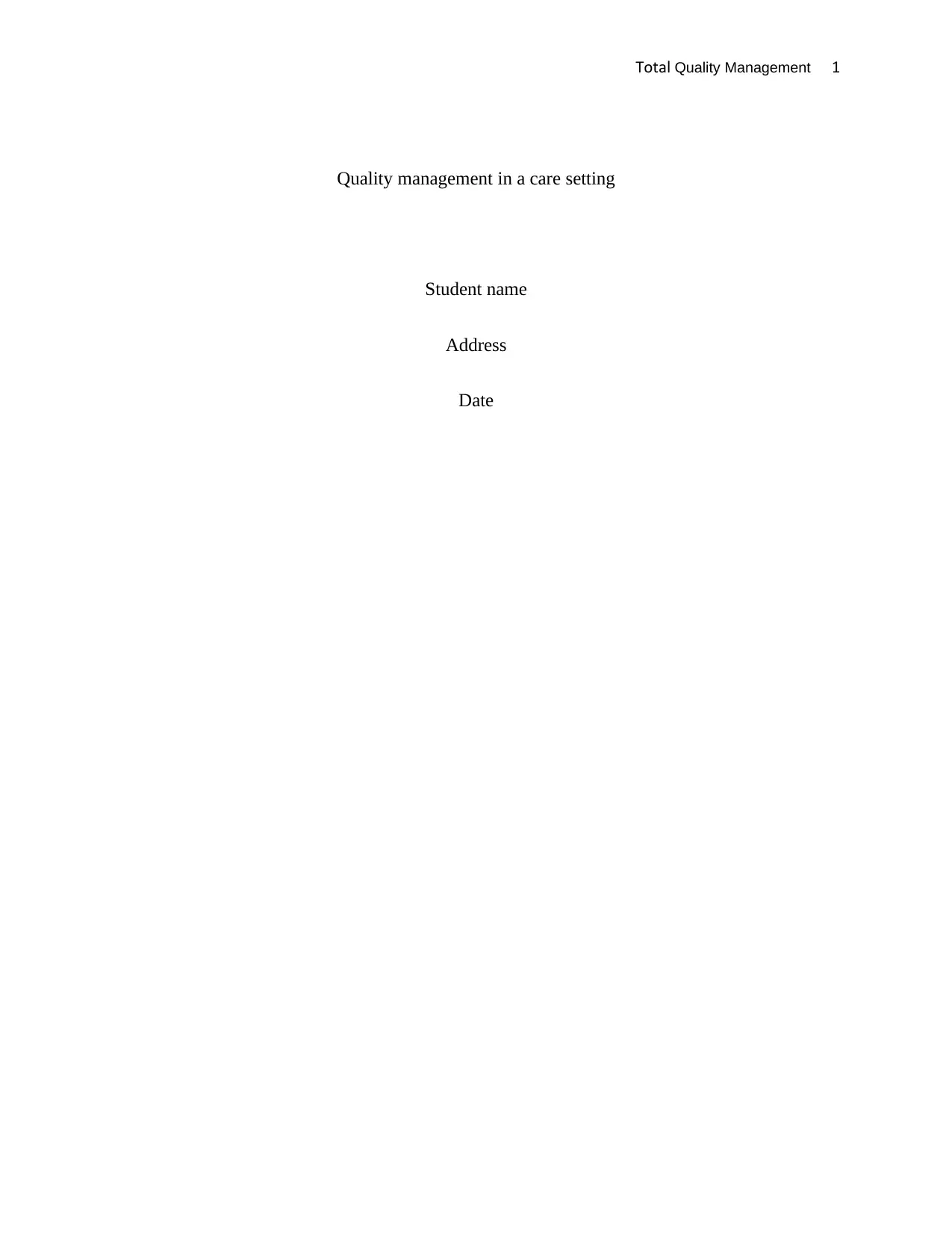
Total Quality Management 1
Quality management in a care setting
Student name
Address
Date
Quality management in a care setting
Student name
Address
Date
Paraphrase This Document
Need a fresh take? Get an instant paraphrase of this document with our AI Paraphraser
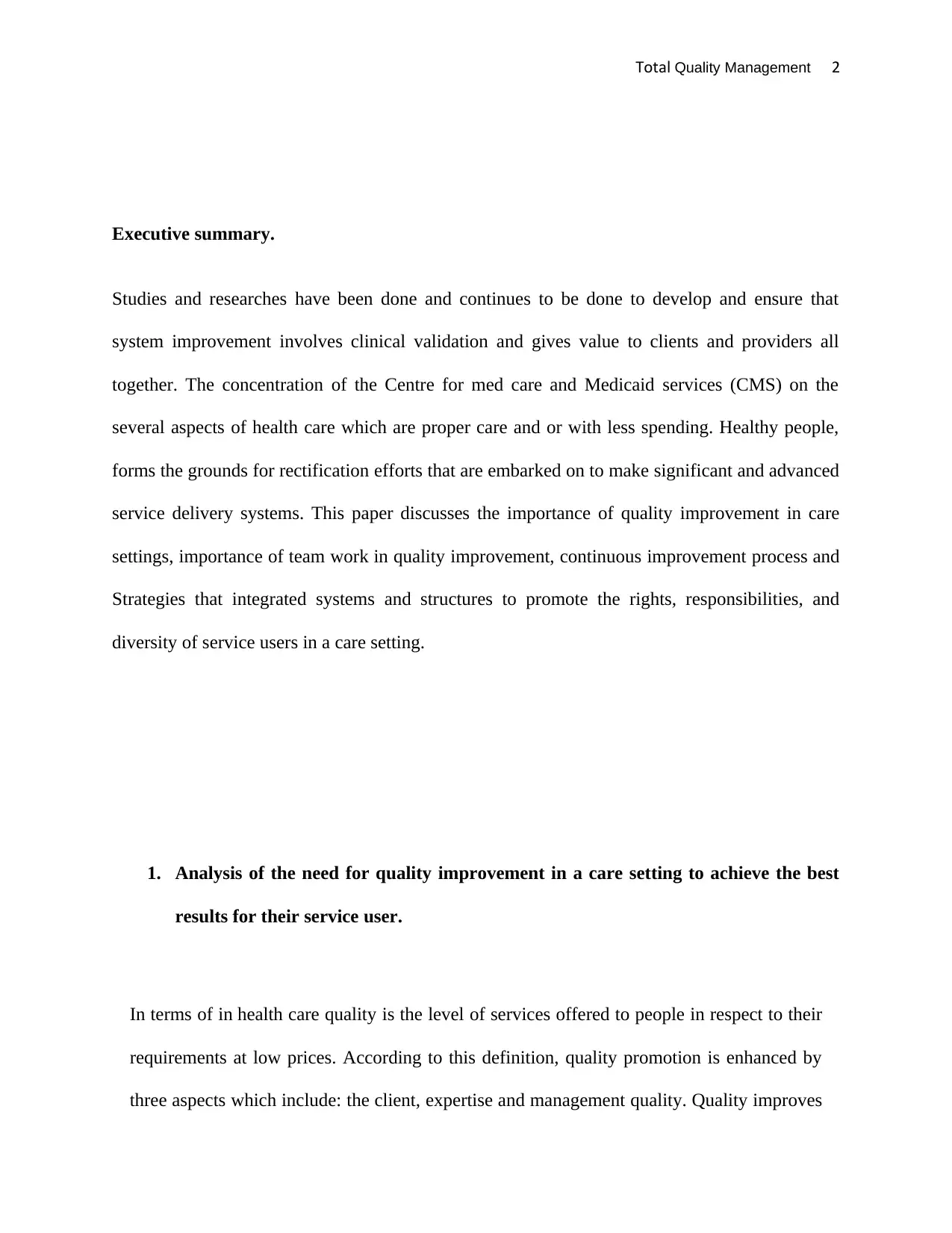
Total Quality Management 2
Executive summary.
Studies and researches have been done and continues to be done to develop and ensure that
system improvement involves clinical validation and gives value to clients and providers all
together. The concentration of the Centre for med care and Medicaid services (CMS) on the
several aspects of health care which are proper care and or with less spending. Healthy people,
forms the grounds for rectification efforts that are embarked on to make significant and advanced
service delivery systems. This paper discusses the importance of quality improvement in care
settings, importance of team work in quality improvement, continuous improvement process and
Strategies that integrated systems and structures to promote the rights, responsibilities, and
diversity of service users in a care setting.
1. Analysis of the need for quality improvement in a care setting to achieve the best
results for their service user.
In terms of in health care quality is the level of services offered to people in respect to their
requirements at low prices. According to this definition, quality promotion is enhanced by
three aspects which include: the client, expertise and management quality. Quality improves
Executive summary.
Studies and researches have been done and continues to be done to develop and ensure that
system improvement involves clinical validation and gives value to clients and providers all
together. The concentration of the Centre for med care and Medicaid services (CMS) on the
several aspects of health care which are proper care and or with less spending. Healthy people,
forms the grounds for rectification efforts that are embarked on to make significant and advanced
service delivery systems. This paper discusses the importance of quality improvement in care
settings, importance of team work in quality improvement, continuous improvement process and
Strategies that integrated systems and structures to promote the rights, responsibilities, and
diversity of service users in a care setting.
1. Analysis of the need for quality improvement in a care setting to achieve the best
results for their service user.
In terms of in health care quality is the level of services offered to people in respect to their
requirements at low prices. According to this definition, quality promotion is enhanced by
three aspects which include: the client, expertise and management quality. Quality improves
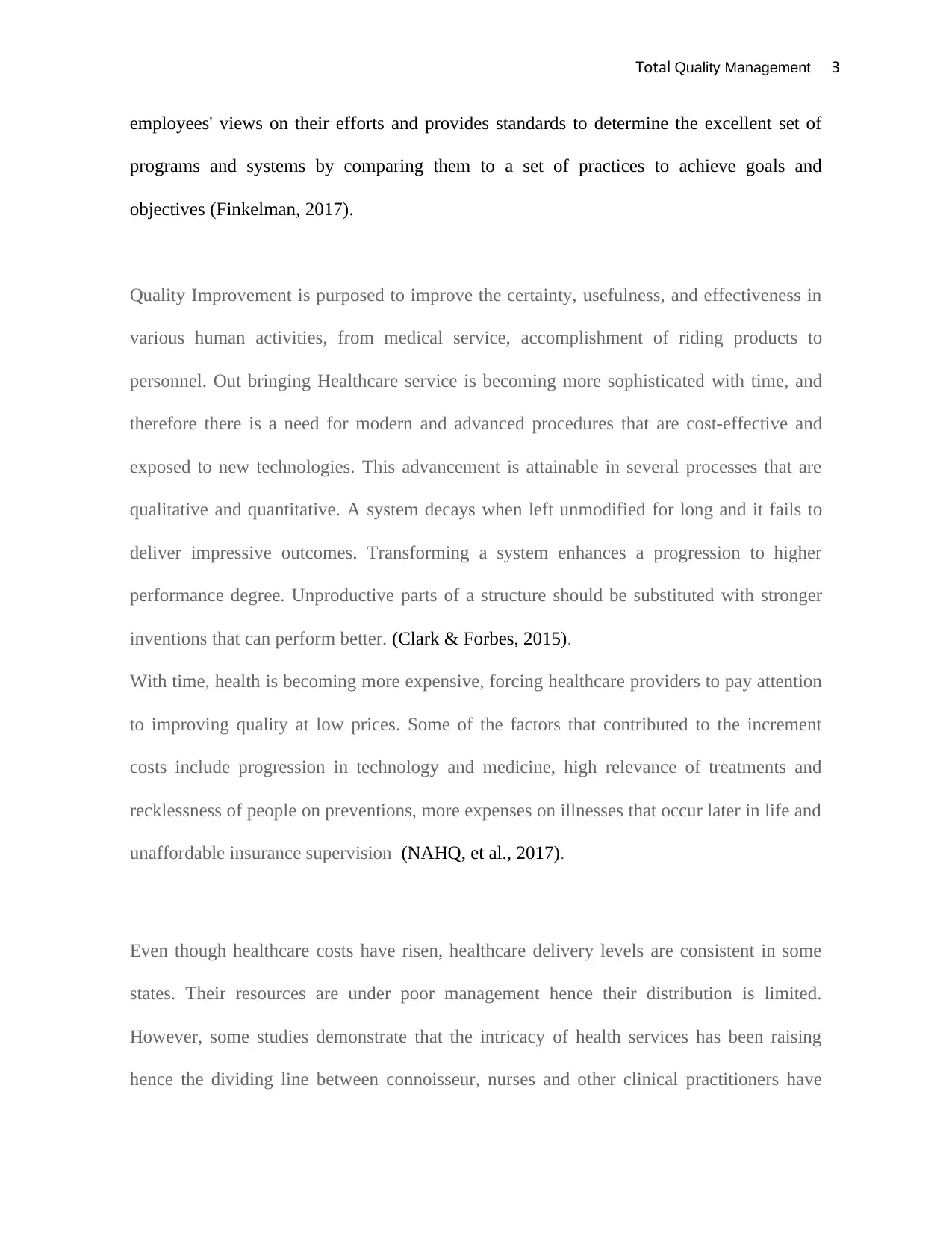
Total Quality Management 3
employees' views on their efforts and provides standards to determine the excellent set of
programs and systems by comparing them to a set of practices to achieve goals and
objectives (Finkelman, 2017).
Quality Improvement is purposed to improve the certainty, usefulness, and effectiveness in
various human activities, from medical service, accomplishment of riding products to
personnel. Out bringing Healthcare service is becoming more sophisticated with time, and
therefore there is a need for modern and advanced procedures that are cost-effective and
exposed to new technologies. This advancement is attainable in several processes that are
qualitative and quantitative. A system decays when left unmodified for long and it fails to
deliver impressive outcomes. Transforming a system enhances a progression to higher
performance degree. Unproductive parts of a structure should be substituted with stronger
inventions that can perform better. (Clark & Forbes, 2015).
With time, health is becoming more expensive, forcing healthcare providers to pay attention
to improving quality at low prices. Some of the factors that contributed to the increment
costs include progression in technology and medicine, high relevance of treatments and
recklessness of people on preventions, more expenses on illnesses that occur later in life and
unaffordable insurance supervision (NAHQ, et al., 2017).
Even though healthcare costs have risen, healthcare delivery levels are consistent in some
states. Their resources are under poor management hence their distribution is limited.
However, some studies demonstrate that the intricacy of health services has been raising
hence the dividing line between connoisseur, nurses and other clinical practitioners have
employees' views on their efforts and provides standards to determine the excellent set of
programs and systems by comparing them to a set of practices to achieve goals and
objectives (Finkelman, 2017).
Quality Improvement is purposed to improve the certainty, usefulness, and effectiveness in
various human activities, from medical service, accomplishment of riding products to
personnel. Out bringing Healthcare service is becoming more sophisticated with time, and
therefore there is a need for modern and advanced procedures that are cost-effective and
exposed to new technologies. This advancement is attainable in several processes that are
qualitative and quantitative. A system decays when left unmodified for long and it fails to
deliver impressive outcomes. Transforming a system enhances a progression to higher
performance degree. Unproductive parts of a structure should be substituted with stronger
inventions that can perform better. (Clark & Forbes, 2015).
With time, health is becoming more expensive, forcing healthcare providers to pay attention
to improving quality at low prices. Some of the factors that contributed to the increment
costs include progression in technology and medicine, high relevance of treatments and
recklessness of people on preventions, more expenses on illnesses that occur later in life and
unaffordable insurance supervision (NAHQ, et al., 2017).
Even though healthcare costs have risen, healthcare delivery levels are consistent in some
states. Their resources are under poor management hence their distribution is limited.
However, some studies demonstrate that the intricacy of health services has been raising
hence the dividing line between connoisseur, nurses and other clinical practitioners have
⊘ This is a preview!⊘
Do you want full access?
Subscribe today to unlock all pages.

Trusted by 1+ million students worldwide
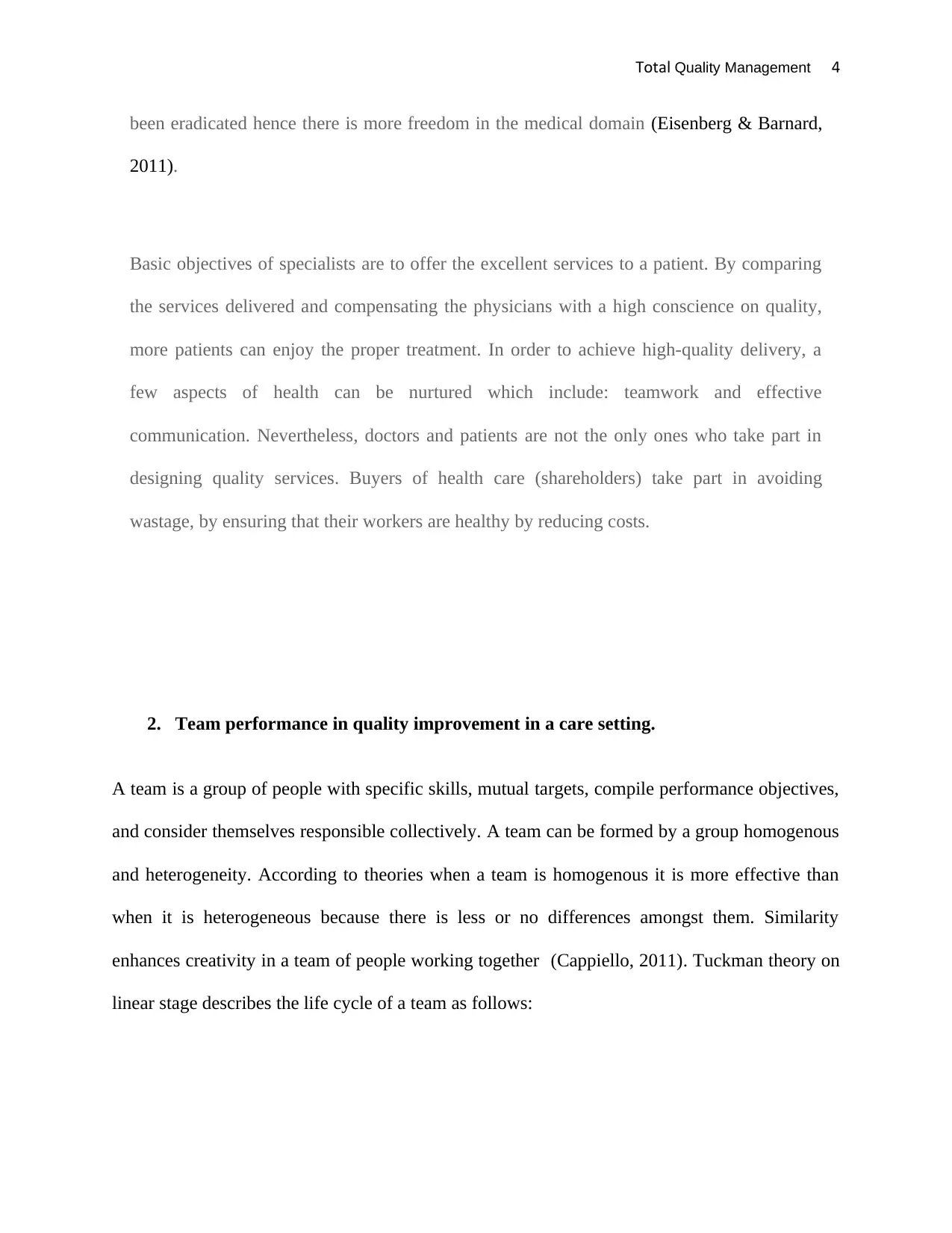
Total Quality Management 4
been eradicated hence there is more freedom in the medical domain (Eisenberg & Barnard,
2011).
Basic objectives of specialists are to offer the excellent services to a patient. By comparing
the services delivered and compensating the physicians with a high conscience on quality,
more patients can enjoy the proper treatment. In order to achieve high-quality delivery, a
few aspects of health can be nurtured which include: teamwork and effective
communication. Nevertheless, doctors and patients are not the only ones who take part in
designing quality services. Buyers of health care (shareholders) take part in avoiding
wastage, by ensuring that their workers are healthy by reducing costs.
2. Team performance in quality improvement in a care setting.
A team is a group of people with specific skills, mutual targets, compile performance objectives,
and consider themselves responsible collectively. A team can be formed by a group homogenous
and heterogeneity. According to theories when a team is homogenous it is more effective than
when it is heterogeneous because there is less or no differences amongst them. Similarity
enhances creativity in a team of people working together (Cappiello, 2011). Tuckman theory on
linear stage describes the life cycle of a team as follows:
been eradicated hence there is more freedom in the medical domain (Eisenberg & Barnard,
2011).
Basic objectives of specialists are to offer the excellent services to a patient. By comparing
the services delivered and compensating the physicians with a high conscience on quality,
more patients can enjoy the proper treatment. In order to achieve high-quality delivery, a
few aspects of health can be nurtured which include: teamwork and effective
communication. Nevertheless, doctors and patients are not the only ones who take part in
designing quality services. Buyers of health care (shareholders) take part in avoiding
wastage, by ensuring that their workers are healthy by reducing costs.
2. Team performance in quality improvement in a care setting.
A team is a group of people with specific skills, mutual targets, compile performance objectives,
and consider themselves responsible collectively. A team can be formed by a group homogenous
and heterogeneity. According to theories when a team is homogenous it is more effective than
when it is heterogeneous because there is less or no differences amongst them. Similarity
enhances creativity in a team of people working together (Cappiello, 2011). Tuckman theory on
linear stage describes the life cycle of a team as follows:
Paraphrase This Document
Need a fresh take? Get an instant paraphrase of this document with our AI Paraphraser
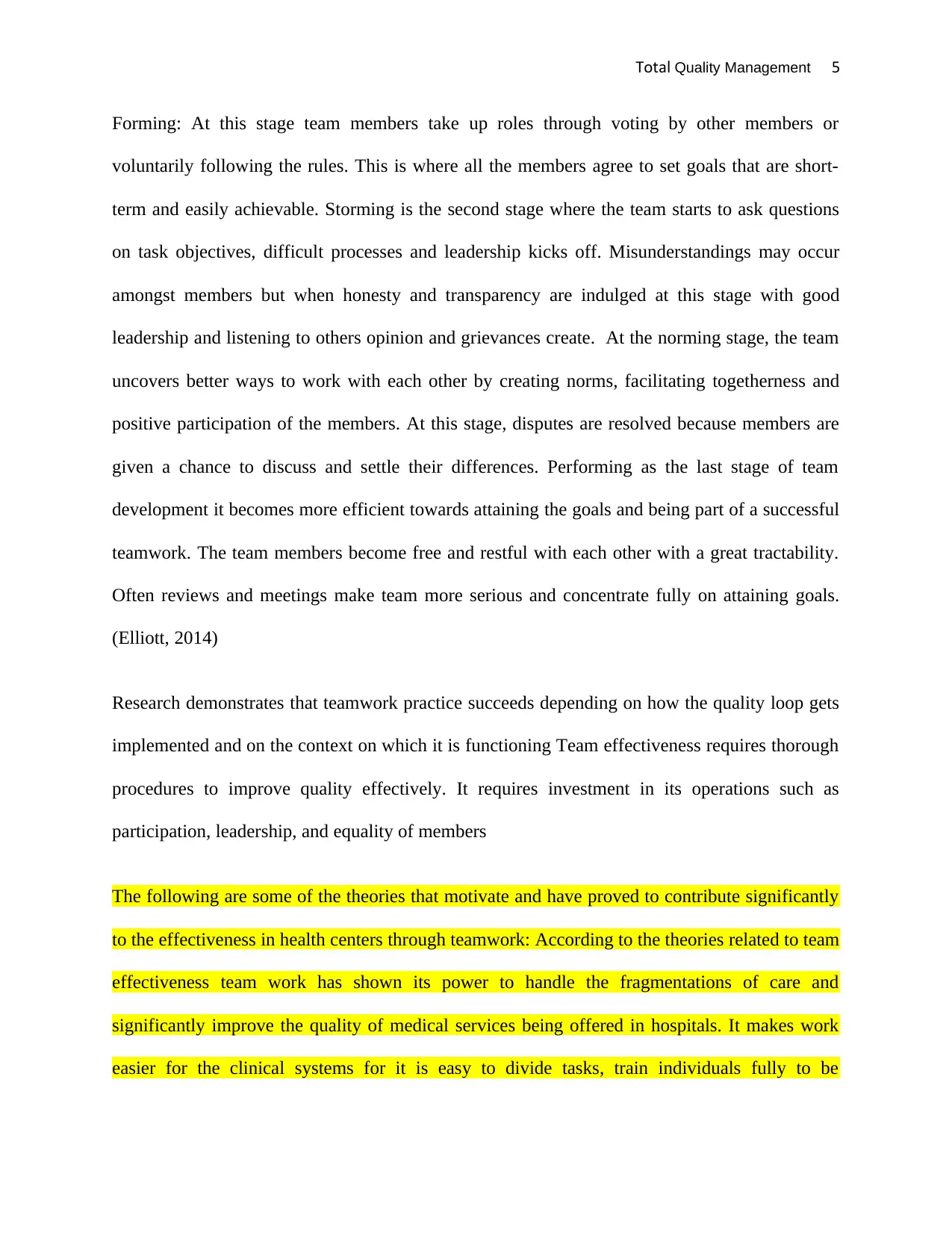
Total Quality Management 5
Forming: At this stage team members take up roles through voting by other members or
voluntarily following the rules. This is where all the members agree to set goals that are short-
term and easily achievable. Storming is the second stage where the team starts to ask questions
on task objectives, difficult processes and leadership kicks off. Misunderstandings may occur
amongst members but when honesty and transparency are indulged at this stage with good
leadership and listening to others opinion and grievances create. At the norming stage, the team
uncovers better ways to work with each other by creating norms, facilitating togetherness and
positive participation of the members. At this stage, disputes are resolved because members are
given a chance to discuss and settle their differences. Performing as the last stage of team
development it becomes more efficient towards attaining the goals and being part of a successful
teamwork. The team members become free and restful with each other with a great tractability.
Often reviews and meetings make team more serious and concentrate fully on attaining goals.
(Elliott, 2014)
Research demonstrates that teamwork practice succeeds depending on how the quality loop gets
implemented and on the context on which it is functioning Team effectiveness requires thorough
procedures to improve quality effectively. It requires investment in its operations such as
participation, leadership, and equality of members
The following are some of the theories that motivate and have proved to contribute significantly
to the effectiveness in health centers through teamwork: According to the theories related to team
effectiveness team work has shown its power to handle the fragmentations of care and
significantly improve the quality of medical services being offered in hospitals. It makes work
easier for the clinical systems for it is easy to divide tasks, train individuals fully to be
Forming: At this stage team members take up roles through voting by other members or
voluntarily following the rules. This is where all the members agree to set goals that are short-
term and easily achievable. Storming is the second stage where the team starts to ask questions
on task objectives, difficult processes and leadership kicks off. Misunderstandings may occur
amongst members but when honesty and transparency are indulged at this stage with good
leadership and listening to others opinion and grievances create. At the norming stage, the team
uncovers better ways to work with each other by creating norms, facilitating togetherness and
positive participation of the members. At this stage, disputes are resolved because members are
given a chance to discuss and settle their differences. Performing as the last stage of team
development it becomes more efficient towards attaining the goals and being part of a successful
teamwork. The team members become free and restful with each other with a great tractability.
Often reviews and meetings make team more serious and concentrate fully on attaining goals.
(Elliott, 2014)
Research demonstrates that teamwork practice succeeds depending on how the quality loop gets
implemented and on the context on which it is functioning Team effectiveness requires thorough
procedures to improve quality effectively. It requires investment in its operations such as
participation, leadership, and equality of members
The following are some of the theories that motivate and have proved to contribute significantly
to the effectiveness in health centers through teamwork: According to the theories related to team
effectiveness team work has shown its power to handle the fragmentations of care and
significantly improve the quality of medical services being offered in hospitals. It makes work
easier for the clinical systems for it is easy to divide tasks, train individuals fully to be
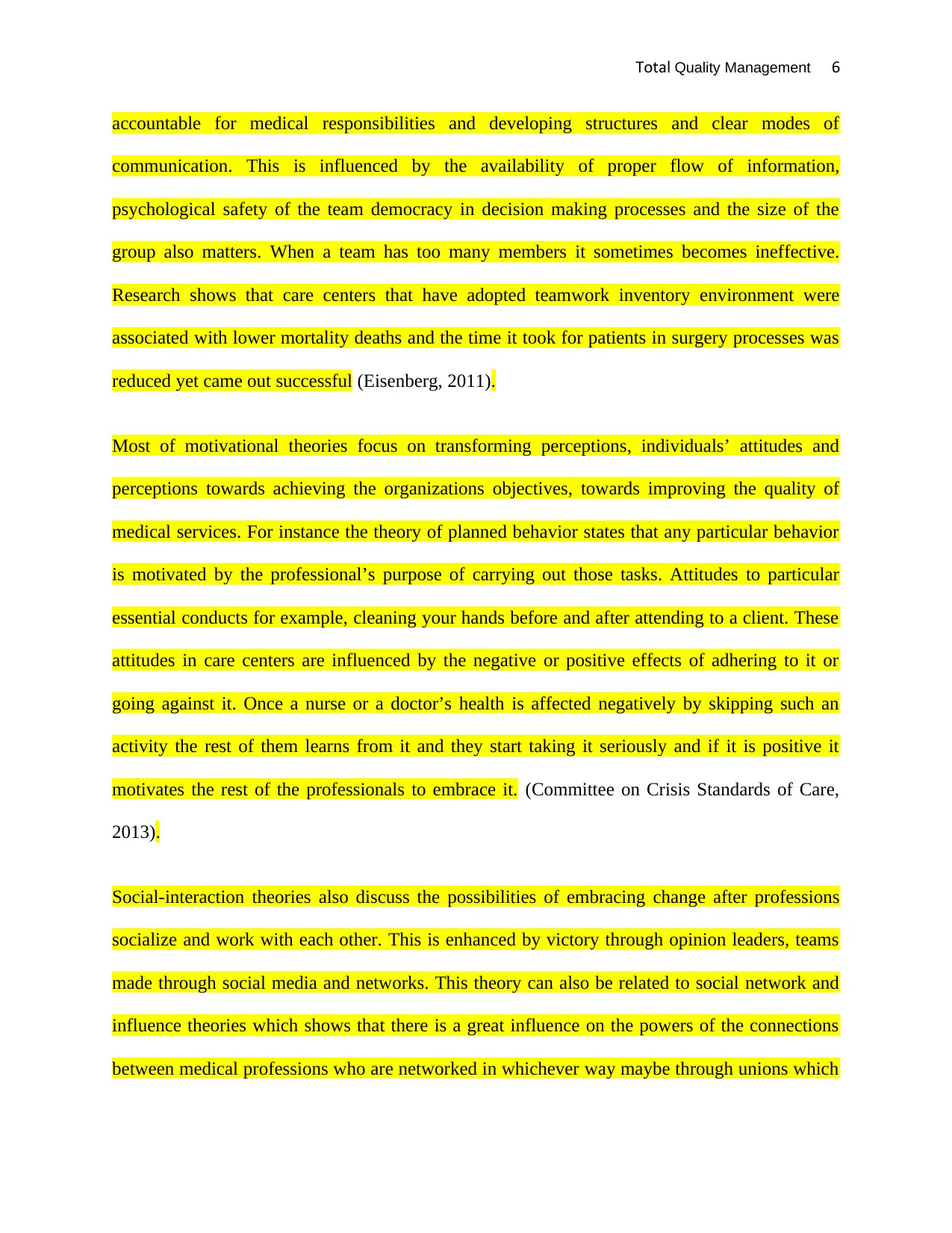
Total Quality Management 6
accountable for medical responsibilities and developing structures and clear modes of
communication. This is influenced by the availability of proper flow of information,
psychological safety of the team democracy in decision making processes and the size of the
group also matters. When a team has too many members it sometimes becomes ineffective.
Research shows that care centers that have adopted teamwork inventory environment were
associated with lower mortality deaths and the time it took for patients in surgery processes was
reduced yet came out successful (Eisenberg, 2011).
Most of motivational theories focus on transforming perceptions, individuals’ attitudes and
perceptions towards achieving the organizations objectives, towards improving the quality of
medical services. For instance the theory of planned behavior states that any particular behavior
is motivated by the professional’s purpose of carrying out those tasks. Attitudes to particular
essential conducts for example, cleaning your hands before and after attending to a client. These
attitudes in care centers are influenced by the negative or positive effects of adhering to it or
going against it. Once a nurse or a doctor’s health is affected negatively by skipping such an
activity the rest of them learns from it and they start taking it seriously and if it is positive it
motivates the rest of the professionals to embrace it. (Committee on Crisis Standards of Care,
2013).
Social-interaction theories also discuss the possibilities of embracing change after professions
socialize and work with each other. This is enhanced by victory through opinion leaders, teams
made through social media and networks. This theory can also be related to social network and
influence theories which shows that there is a great influence on the powers of the connections
between medical professions who are networked in whichever way maybe through unions which
accountable for medical responsibilities and developing structures and clear modes of
communication. This is influenced by the availability of proper flow of information,
psychological safety of the team democracy in decision making processes and the size of the
group also matters. When a team has too many members it sometimes becomes ineffective.
Research shows that care centers that have adopted teamwork inventory environment were
associated with lower mortality deaths and the time it took for patients in surgery processes was
reduced yet came out successful (Eisenberg, 2011).
Most of motivational theories focus on transforming perceptions, individuals’ attitudes and
perceptions towards achieving the organizations objectives, towards improving the quality of
medical services. For instance the theory of planned behavior states that any particular behavior
is motivated by the professional’s purpose of carrying out those tasks. Attitudes to particular
essential conducts for example, cleaning your hands before and after attending to a client. These
attitudes in care centers are influenced by the negative or positive effects of adhering to it or
going against it. Once a nurse or a doctor’s health is affected negatively by skipping such an
activity the rest of them learns from it and they start taking it seriously and if it is positive it
motivates the rest of the professionals to embrace it. (Committee on Crisis Standards of Care,
2013).
Social-interaction theories also discuss the possibilities of embracing change after professions
socialize and work with each other. This is enhanced by victory through opinion leaders, teams
made through social media and networks. This theory can also be related to social network and
influence theories which shows that there is a great influence on the powers of the connections
between medical professions who are networked in whichever way maybe through unions which
⊘ This is a preview!⊘
Do you want full access?
Subscribe today to unlock all pages.

Trusted by 1+ million students worldwide
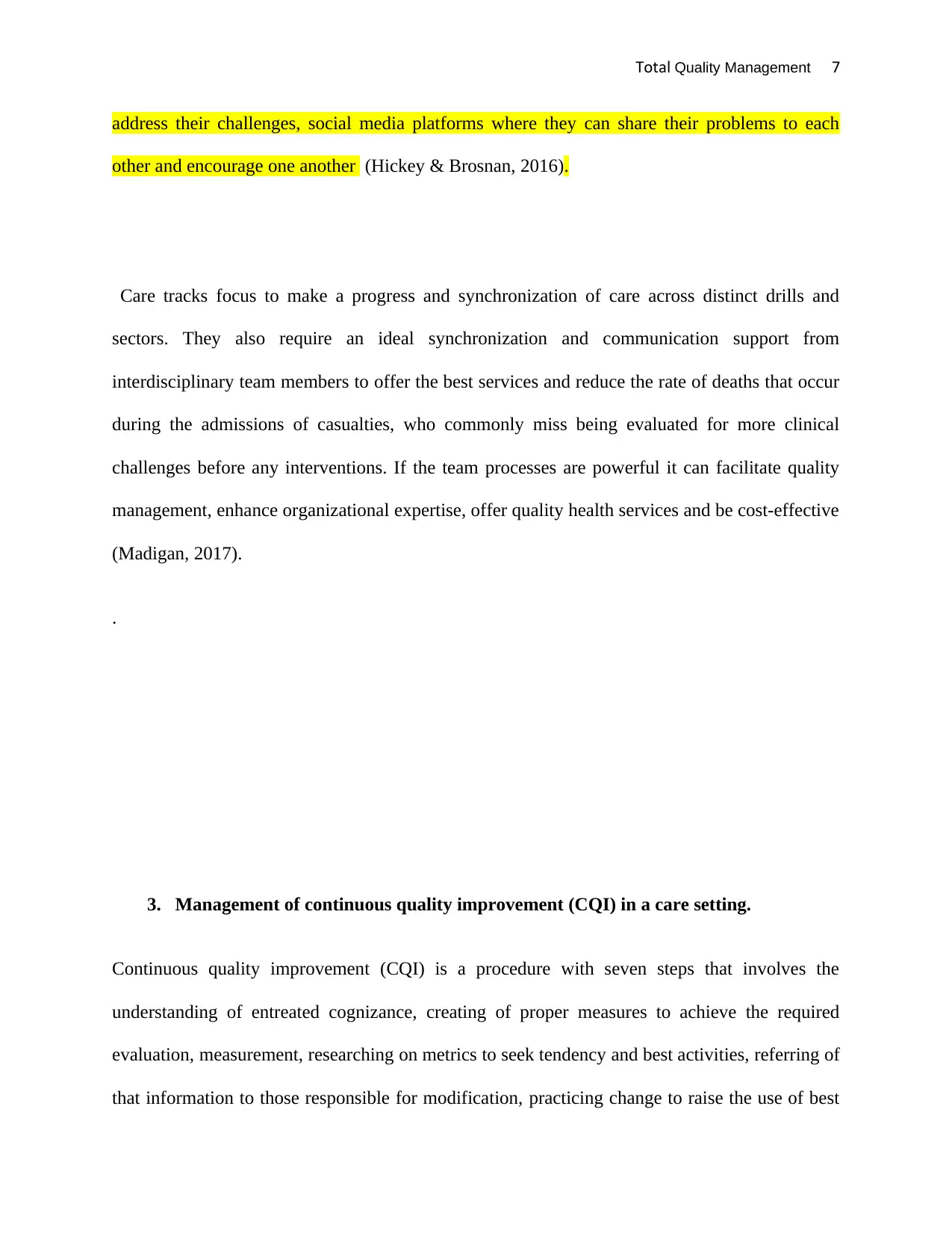
Total Quality Management 7
address their challenges, social media platforms where they can share their problems to each
other and encourage one another (Hickey & Brosnan, 2016).
Care tracks focus to make a progress and synchronization of care across distinct drills and
sectors. They also require an ideal synchronization and communication support from
interdisciplinary team members to offer the best services and reduce the rate of deaths that occur
during the admissions of casualties, who commonly miss being evaluated for more clinical
challenges before any interventions. If the team processes are powerful it can facilitate quality
management, enhance organizational expertise, offer quality health services and be cost-effective
(Madigan, 2017).
.
3. Management of continuous quality improvement (CQI) in a care setting.
Continuous quality improvement (CQI) is a procedure with seven steps that involves the
understanding of entreated cognizance, creating of proper measures to achieve the required
evaluation, measurement, researching on metrics to seek tendency and best activities, referring of
that information to those responsible for modification, practicing change to raise the use of best
address their challenges, social media platforms where they can share their problems to each
other and encourage one another (Hickey & Brosnan, 2016).
Care tracks focus to make a progress and synchronization of care across distinct drills and
sectors. They also require an ideal synchronization and communication support from
interdisciplinary team members to offer the best services and reduce the rate of deaths that occur
during the admissions of casualties, who commonly miss being evaluated for more clinical
challenges before any interventions. If the team processes are powerful it can facilitate quality
management, enhance organizational expertise, offer quality health services and be cost-effective
(Madigan, 2017).
.
3. Management of continuous quality improvement (CQI) in a care setting.
Continuous quality improvement (CQI) is a procedure with seven steps that involves the
understanding of entreated cognizance, creating of proper measures to achieve the required
evaluation, measurement, researching on metrics to seek tendency and best activities, referring of
that information to those responsible for modification, practicing change to raise the use of best
Paraphrase This Document
Need a fresh take? Get an instant paraphrase of this document with our AI Paraphraser
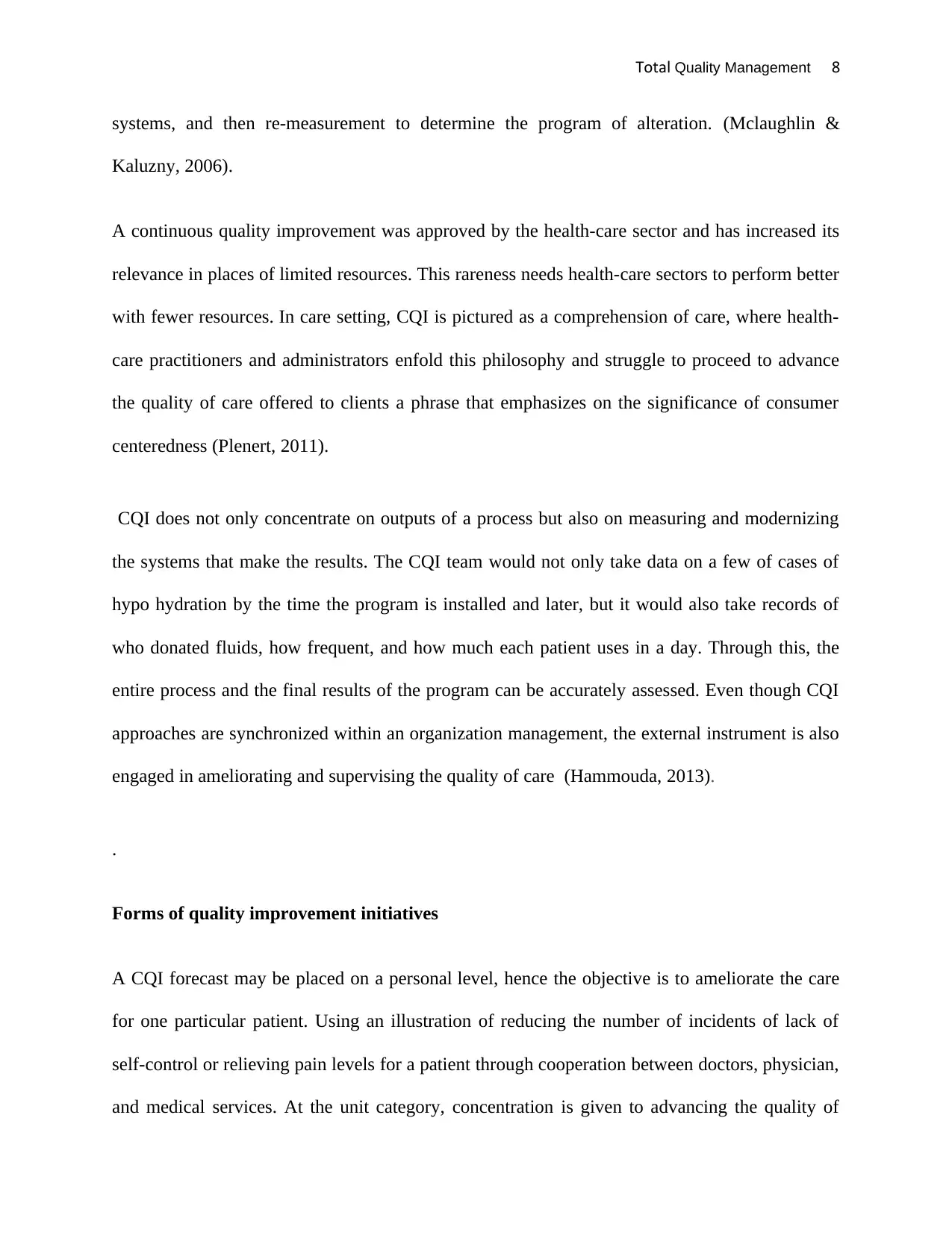
Total Quality Management 8
systems, and then re-measurement to determine the program of alteration. (Mclaughlin &
Kaluzny, 2006).
A continuous quality improvement was approved by the health-care sector and has increased its
relevance in places of limited resources. This rareness needs health-care sectors to perform better
with fewer resources. In care setting, CQI is pictured as a comprehension of care, where health-
care practitioners and administrators enfold this philosophy and struggle to proceed to advance
the quality of care offered to clients a phrase that emphasizes on the significance of consumer
centeredness (Plenert, 2011).
CQI does not only concentrate on outputs of a process but also on measuring and modernizing
the systems that make the results. The CQI team would not only take data on a few of cases of
hypo hydration by the time the program is installed and later, but it would also take records of
who donated fluids, how frequent, and how much each patient uses in a day. Through this, the
entire process and the final results of the program can be accurately assessed. Even though CQI
approaches are synchronized within an organization management, the external instrument is also
engaged in ameliorating and supervising the quality of care (Hammouda, 2013).
.
Forms of quality improvement initiatives
A CQI forecast may be placed on a personal level, hence the objective is to ameliorate the care
for one particular patient. Using an illustration of reducing the number of incidents of lack of
self-control or relieving pain levels for a patient through cooperation between doctors, physician,
and medical services. At the unit category, concentration is given to advancing the quality of
systems, and then re-measurement to determine the program of alteration. (Mclaughlin &
Kaluzny, 2006).
A continuous quality improvement was approved by the health-care sector and has increased its
relevance in places of limited resources. This rareness needs health-care sectors to perform better
with fewer resources. In care setting, CQI is pictured as a comprehension of care, where health-
care practitioners and administrators enfold this philosophy and struggle to proceed to advance
the quality of care offered to clients a phrase that emphasizes on the significance of consumer
centeredness (Plenert, 2011).
CQI does not only concentrate on outputs of a process but also on measuring and modernizing
the systems that make the results. The CQI team would not only take data on a few of cases of
hypo hydration by the time the program is installed and later, but it would also take records of
who donated fluids, how frequent, and how much each patient uses in a day. Through this, the
entire process and the final results of the program can be accurately assessed. Even though CQI
approaches are synchronized within an organization management, the external instrument is also
engaged in ameliorating and supervising the quality of care (Hammouda, 2013).
.
Forms of quality improvement initiatives
A CQI forecast may be placed on a personal level, hence the objective is to ameliorate the care
for one particular patient. Using an illustration of reducing the number of incidents of lack of
self-control or relieving pain levels for a patient through cooperation between doctors, physician,
and medical services. At the unit category, concentration is given to advancing the quality of
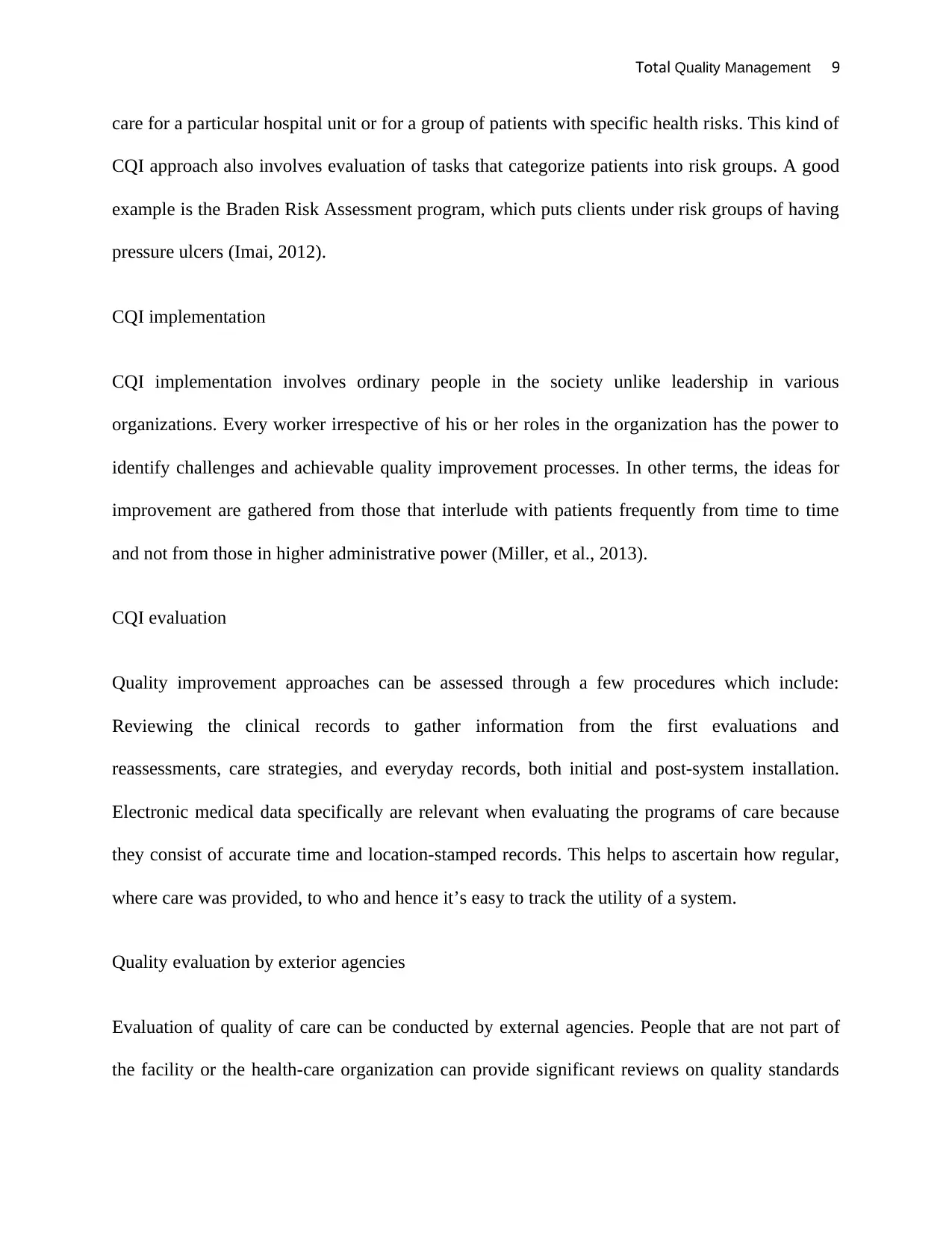
Total Quality Management 9
care for a particular hospital unit or for a group of patients with specific health risks. This kind of
CQI approach also involves evaluation of tasks that categorize patients into risk groups. A good
example is the Braden Risk Assessment program, which puts clients under risk groups of having
pressure ulcers (Imai, 2012).
CQI implementation
CQI implementation involves ordinary people in the society unlike leadership in various
organizations. Every worker irrespective of his or her roles in the organization has the power to
identify challenges and achievable quality improvement processes. In other terms, the ideas for
improvement are gathered from those that interlude with patients frequently from time to time
and not from those in higher administrative power (Miller, et al., 2013).
CQI evaluation
Quality improvement approaches can be assessed through a few procedures which include:
Reviewing the clinical records to gather information from the first evaluations and
reassessments, care strategies, and everyday records, both initial and post-system installation.
Electronic medical data specifically are relevant when evaluating the programs of care because
they consist of accurate time and location-stamped records. This helps to ascertain how regular,
where care was provided, to who and hence it’s easy to track the utility of a system.
Quality evaluation by exterior agencies
Evaluation of quality of care can be conducted by external agencies. People that are not part of
the facility or the health-care organization can provide significant reviews on quality standards
care for a particular hospital unit or for a group of patients with specific health risks. This kind of
CQI approach also involves evaluation of tasks that categorize patients into risk groups. A good
example is the Braden Risk Assessment program, which puts clients under risk groups of having
pressure ulcers (Imai, 2012).
CQI implementation
CQI implementation involves ordinary people in the society unlike leadership in various
organizations. Every worker irrespective of his or her roles in the organization has the power to
identify challenges and achievable quality improvement processes. In other terms, the ideas for
improvement are gathered from those that interlude with patients frequently from time to time
and not from those in higher administrative power (Miller, et al., 2013).
CQI evaluation
Quality improvement approaches can be assessed through a few procedures which include:
Reviewing the clinical records to gather information from the first evaluations and
reassessments, care strategies, and everyday records, both initial and post-system installation.
Electronic medical data specifically are relevant when evaluating the programs of care because
they consist of accurate time and location-stamped records. This helps to ascertain how regular,
where care was provided, to who and hence it’s easy to track the utility of a system.
Quality evaluation by exterior agencies
Evaluation of quality of care can be conducted by external agencies. People that are not part of
the facility or the health-care organization can provide significant reviews on quality standards
⊘ This is a preview!⊘
Do you want full access?
Subscribe today to unlock all pages.

Trusted by 1+ million students worldwide
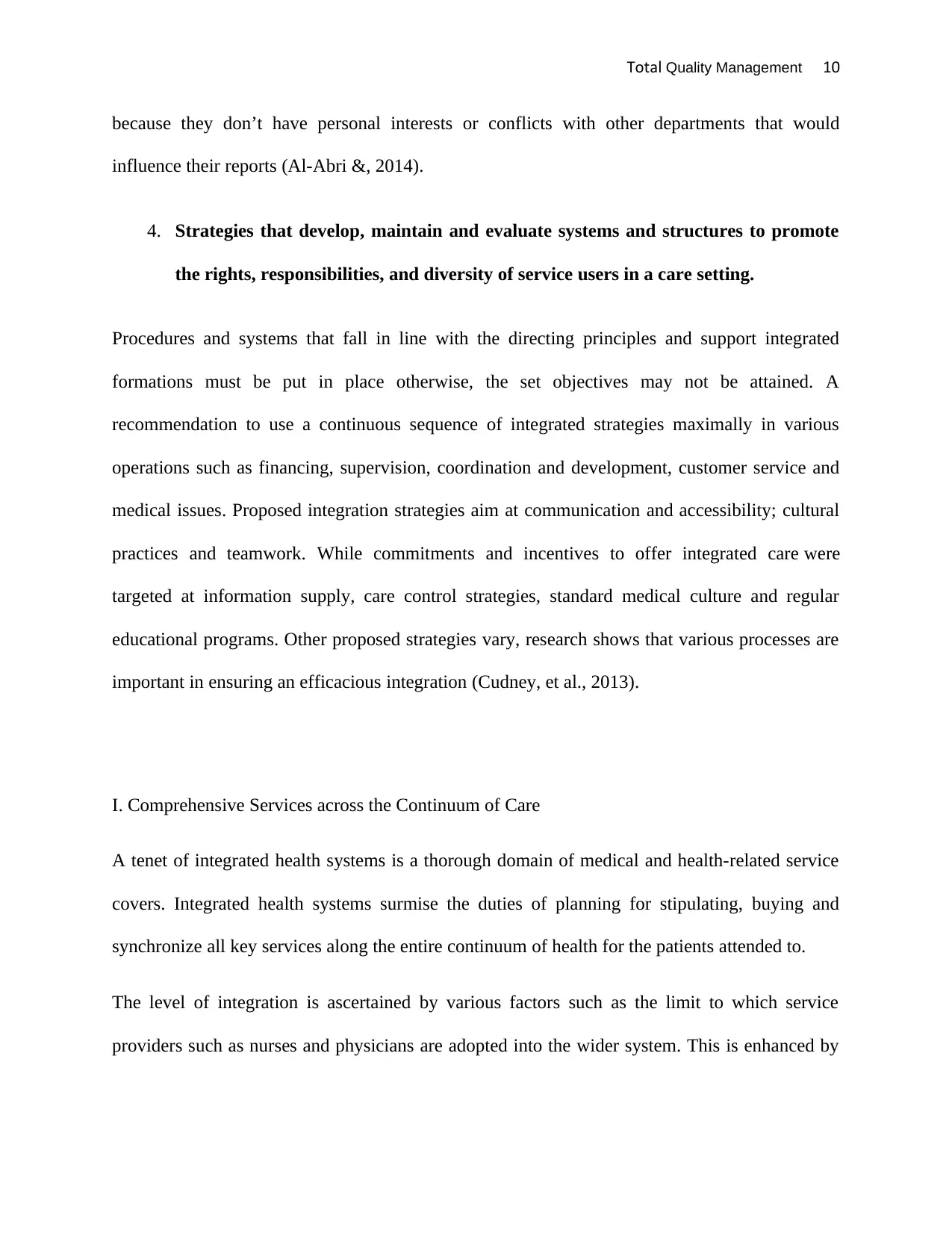
Total Quality Management 10
because they don’t have personal interests or conflicts with other departments that would
influence their reports (Al-Abri &, 2014).
4. Strategies that develop, maintain and evaluate systems and structures to promote
the rights, responsibilities, and diversity of service users in a care setting.
Procedures and systems that fall in line with the directing principles and support integrated
formations must be put in place otherwise, the set objectives may not be attained. A
recommendation to use a continuous sequence of integrated strategies maximally in various
operations such as financing, supervision, coordination and development, customer service and
medical issues. Proposed integration strategies aim at communication and accessibility; cultural
practices and teamwork. While commitments and incentives to offer integrated care were
targeted at information supply, care control strategies, standard medical culture and regular
educational programs. Other proposed strategies vary, research shows that various processes are
important in ensuring an efficacious integration (Cudney, et al., 2013).
I. Comprehensive Services across the Continuum of Care
A tenet of integrated health systems is a thorough domain of medical and health-related service
covers. Integrated health systems surmise the duties of planning for stipulating, buying and
synchronize all key services along the entire continuum of health for the patients attended to.
The level of integration is ascertained by various factors such as the limit to which service
providers such as nurses and physicians are adopted into the wider system. This is enhanced by
because they don’t have personal interests or conflicts with other departments that would
influence their reports (Al-Abri &, 2014).
4. Strategies that develop, maintain and evaluate systems and structures to promote
the rights, responsibilities, and diversity of service users in a care setting.
Procedures and systems that fall in line with the directing principles and support integrated
formations must be put in place otherwise, the set objectives may not be attained. A
recommendation to use a continuous sequence of integrated strategies maximally in various
operations such as financing, supervision, coordination and development, customer service and
medical issues. Proposed integration strategies aim at communication and accessibility; cultural
practices and teamwork. While commitments and incentives to offer integrated care were
targeted at information supply, care control strategies, standard medical culture and regular
educational programs. Other proposed strategies vary, research shows that various processes are
important in ensuring an efficacious integration (Cudney, et al., 2013).
I. Comprehensive Services across the Continuum of Care
A tenet of integrated health systems is a thorough domain of medical and health-related service
covers. Integrated health systems surmise the duties of planning for stipulating, buying and
synchronize all key services along the entire continuum of health for the patients attended to.
The level of integration is ascertained by various factors such as the limit to which service
providers such as nurses and physicians are adopted into the wider system. This is enhanced by
Paraphrase This Document
Need a fresh take? Get an instant paraphrase of this document with our AI Paraphraser
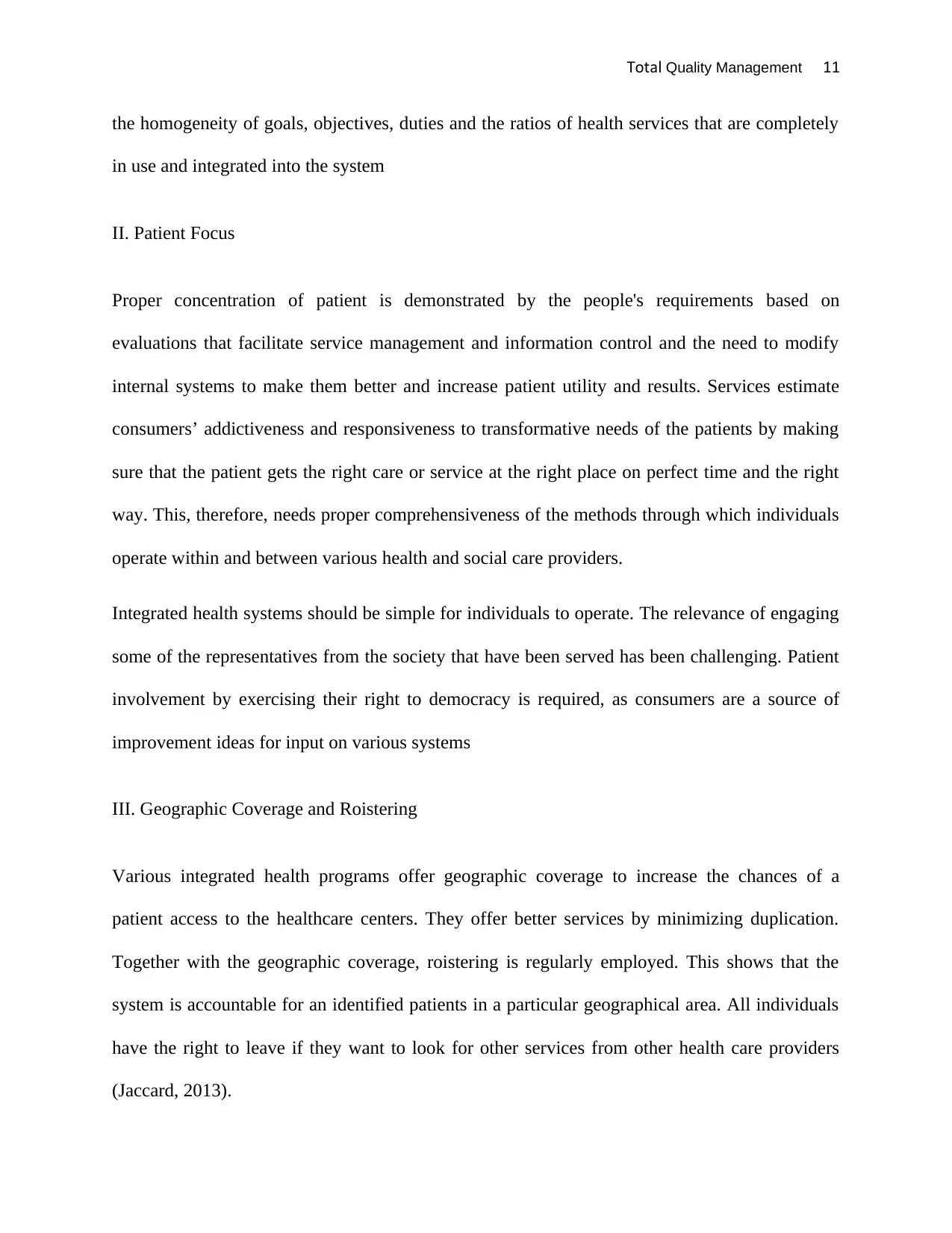
Total Quality Management 11
the homogeneity of goals, objectives, duties and the ratios of health services that are completely
in use and integrated into the system
II. Patient Focus
Proper concentration of patient is demonstrated by the people's requirements based on
evaluations that facilitate service management and information control and the need to modify
internal systems to make them better and increase patient utility and results. Services estimate
consumers’ addictiveness and responsiveness to transformative needs of the patients by making
sure that the patient gets the right care or service at the right place on perfect time and the right
way. This, therefore, needs proper comprehensiveness of the methods through which individuals
operate within and between various health and social care providers.
Integrated health systems should be simple for individuals to operate. The relevance of engaging
some of the representatives from the society that have been served has been challenging. Patient
involvement by exercising their right to democracy is required, as consumers are a source of
improvement ideas for input on various systems
III. Geographic Coverage and Roistering
Various integrated health programs offer geographic coverage to increase the chances of a
patient access to the healthcare centers. They offer better services by minimizing duplication.
Together with the geographic coverage, roistering is regularly employed. This shows that the
system is accountable for an identified patients in a particular geographical area. All individuals
have the right to leave if they want to look for other services from other health care providers
(Jaccard, 2013).
the homogeneity of goals, objectives, duties and the ratios of health services that are completely
in use and integrated into the system
II. Patient Focus
Proper concentration of patient is demonstrated by the people's requirements based on
evaluations that facilitate service management and information control and the need to modify
internal systems to make them better and increase patient utility and results. Services estimate
consumers’ addictiveness and responsiveness to transformative needs of the patients by making
sure that the patient gets the right care or service at the right place on perfect time and the right
way. This, therefore, needs proper comprehensiveness of the methods through which individuals
operate within and between various health and social care providers.
Integrated health systems should be simple for individuals to operate. The relevance of engaging
some of the representatives from the society that have been served has been challenging. Patient
involvement by exercising their right to democracy is required, as consumers are a source of
improvement ideas for input on various systems
III. Geographic Coverage and Roistering
Various integrated health programs offer geographic coverage to increase the chances of a
patient access to the healthcare centers. They offer better services by minimizing duplication.
Together with the geographic coverage, roistering is regularly employed. This shows that the
system is accountable for an identified patients in a particular geographical area. All individuals
have the right to leave if they want to look for other services from other health care providers
(Jaccard, 2013).
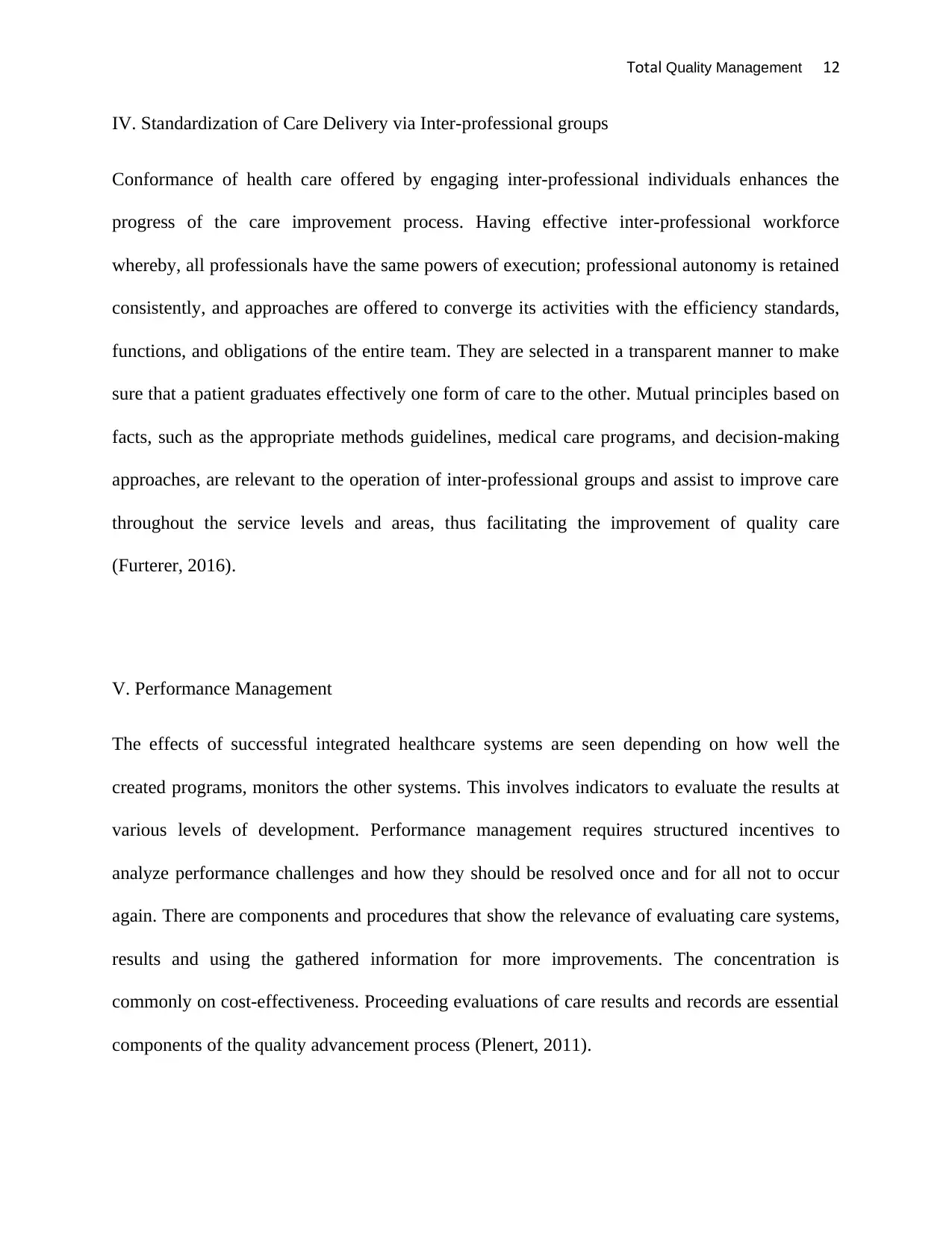
Total Quality Management 12
IV. Standardization of Care Delivery via Inter-professional groups
Conformance of health care offered by engaging inter-professional individuals enhances the
progress of the care improvement process. Having effective inter-professional workforce
whereby, all professionals have the same powers of execution; professional autonomy is retained
consistently, and approaches are offered to converge its activities with the efficiency standards,
functions, and obligations of the entire team. They are selected in a transparent manner to make
sure that a patient graduates effectively one form of care to the other. Mutual principles based on
facts, such as the appropriate methods guidelines, medical care programs, and decision-making
approaches, are relevant to the operation of inter-professional groups and assist to improve care
throughout the service levels and areas, thus facilitating the improvement of quality care
(Furterer, 2016).
V. Performance Management
The effects of successful integrated healthcare systems are seen depending on how well the
created programs, monitors the other systems. This involves indicators to evaluate the results at
various levels of development. Performance management requires structured incentives to
analyze performance challenges and how they should be resolved once and for all not to occur
again. There are components and procedures that show the relevance of evaluating care systems,
results and using the gathered information for more improvements. The concentration is
commonly on cost-effectiveness. Proceeding evaluations of care results and records are essential
components of the quality advancement process (Plenert, 2011).
IV. Standardization of Care Delivery via Inter-professional groups
Conformance of health care offered by engaging inter-professional individuals enhances the
progress of the care improvement process. Having effective inter-professional workforce
whereby, all professionals have the same powers of execution; professional autonomy is retained
consistently, and approaches are offered to converge its activities with the efficiency standards,
functions, and obligations of the entire team. They are selected in a transparent manner to make
sure that a patient graduates effectively one form of care to the other. Mutual principles based on
facts, such as the appropriate methods guidelines, medical care programs, and decision-making
approaches, are relevant to the operation of inter-professional groups and assist to improve care
throughout the service levels and areas, thus facilitating the improvement of quality care
(Furterer, 2016).
V. Performance Management
The effects of successful integrated healthcare systems are seen depending on how well the
created programs, monitors the other systems. This involves indicators to evaluate the results at
various levels of development. Performance management requires structured incentives to
analyze performance challenges and how they should be resolved once and for all not to occur
again. There are components and procedures that show the relevance of evaluating care systems,
results and using the gathered information for more improvements. The concentration is
commonly on cost-effectiveness. Proceeding evaluations of care results and records are essential
components of the quality advancement process (Plenert, 2011).
⊘ This is a preview!⊘
Do you want full access?
Subscribe today to unlock all pages.

Trusted by 1+ million students worldwide
1 out of 18
Related Documents
Your All-in-One AI-Powered Toolkit for Academic Success.
+13062052269
info@desklib.com
Available 24*7 on WhatsApp / Email
![[object Object]](/_next/static/media/star-bottom.7253800d.svg)
Unlock your academic potential
Copyright © 2020–2025 A2Z Services. All Rights Reserved. Developed and managed by ZUCOL.





